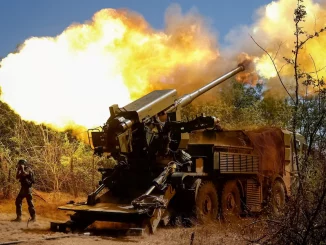
Russia fired a record 728 Shahed and decoy drones at Ukraine overnight, as well as 13 missiles, the Ukrainian air force said Wednesday. It is the latest escalation during mounting Russian aerial and ground attacks in the more than three-year war.
| Published July 10, 2025
In one of the most intense escalations since the full-scale war began, Russia launched a record-breaking aerial assault on Ukraine, deploying over 700 drones in a single night. The attack came just hours after former U.S. President Donald Trump vowed to resume the flow of American weapons to Kyiv—signaling a renewed phase in the conflict, where military resolve and political timing collide. As explosions rocked cities across Ukraine, including strikes near NATO territory, global eyes turned once again to the widening stakes of a war with no clear end in sight.
🚨 Record-Breaking Drone Attack by Russia
-
728 drones and 13 missiles struck Ukraine early on July 9, 2025, marking the largest aerial assault since the 2022 invasion
-
Among these were six hypersonic missiles, which penetrated air defenses and caused structural damage. Debris from drones resulted in at least one fatality in western Ukraine, while the Donetsk frontline saw eight more deaths
-
The city of Lutsk, near the Polish border, was heavily hit—numerous buildings and facilities damaged. Polish jets were scrambled to defend airspace
🇺🇸 Trump’s Shift & U.S. Arms Delivery
-
Former President Donald Trump, now back in the White House, has pledged defensive weaponry to Ukraine, including the potential reactivation of Patriot missile systems
-
This pledge followed a brief Pentagon pause on munitions. Weapons like 155 mm artillery shells and GMLRS rocket rounds have resumed delivery
🔥 Continued Threats & Air Defence Strain
-
A follow-up assault on July 10 hit Kyiv again with drones and missiles, killing two people, injuring around 13, and igniting fires across several districts
-
Damage was reported in at least six city districts, including Shevchenkivskyi
🗣 Reactions: Zelenskiy, Europe & Sanctions Push
-
Ukrainian President Zelenskiy is calling for “biting sanctions” on oil revenues and countries still purchasing Russian exports .
-
He also held talks with Pope Leo in Rome, exploring the possibility of peace negotiations hosted by the Vatican—yet Russia has declined
-
German Chancellor Friedrich Merz labeled diplomatic channels “exhausted” and pledged additional air defence systems during upcoming meetings in Rome
 Resulting Effects:
Resulting Effects:
The aftermath of Russia’s unprecedented drone and missile assault left a trail of destruction across Ukraine:
-
🏚️ Civilian Casualties: At least nine people were killed, including one in the western city of Lutsk, and dozens were injured across multiple regions. Emergency responders battled fires sparked by falling debris as critical infrastructure took hits.
-
🏙️ Urban Damage: The capital, Kyiv, suffered structural damage in at least six districts, with drone fragments igniting blazes and shattering windows. In Donetsk, already a war-scarred frontline region, multiple fatalities were reported amid intense shelling.
-
⚡ Air Defense Strain: Ukraine’s anti-air systems intercepted the majority of the drones, but advanced hypersonic missiles slipped through defenses—raising concerns about growing vulnerabilities and the need for Western-supplied systems like Patriots and IRIS-Ts.
-
🛫 NATO Response: The strike’s proximity to Poland triggered a swift NATO alert. Polish fighter jets were scrambled, and allied forces monitored the skies—underscoring the continued risk of spillover into NATO territory.
-
📉 Economic Disruption: Ukraine’s energy and transport sectors faced renewed pressure as drone attacks targeted infrastructure. This adds to the ongoing cost of war on the nation’s economy, already burdened by displacement, defense spending, and recovery efforts.
 Bottom Line:
Bottom Line:
Russia’s largest drone assault to date is more than just a show of force—it’s a message. As Ukraine braces under the weight of nonstop bombardment, and as the United States signals renewed military backing under Trump, the conflict appears to be entering a new and unpredictable phase. While Western support may bolster Ukrainian defenses, it also risks deeper escalation with a cornered Kremlin.
Whether this turning point leads to deterrence or provokes further retaliation remains uncertain—but what’s clear is that the war is far from over, and the next moves from Washington, Moscow, and NATO may decide how—and when—this deadly chapter ends.





Be the first to comment